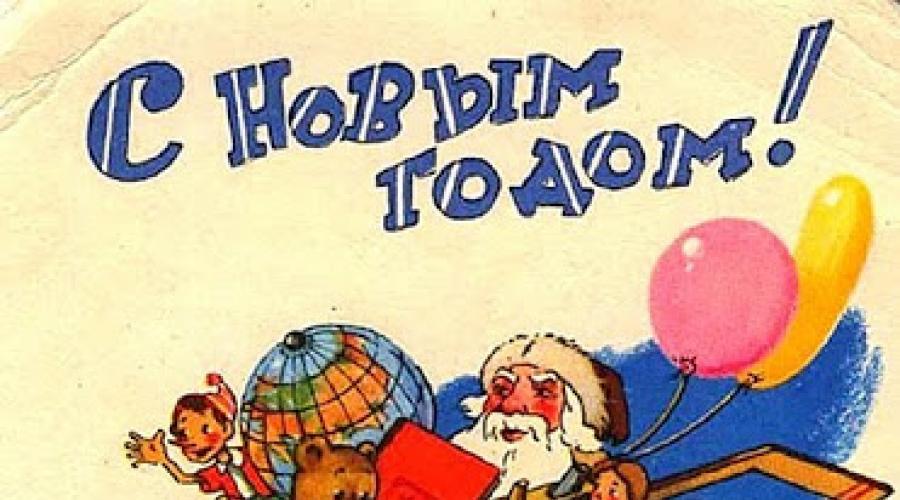Santa Claus postcards are old. Soviet New Year cards

And after a while, the industry produced a wide range of postcards that were pleasing to the eye in the windows of newsstands filled with traditionally discreet printed matter.
And although the print quality and the brightness of the colors of Soviet postcards were inferior to imported ones, these shortcomings were atoned for by the originality of the subjects and the high professionalism of the artists.

The true heyday of the Soviet New Year postcard came in the 60s. The number of plots has increased: such motives as space exploration, the struggle for peace appear. Winter landscapes were crowned with wishes: "May the New Year bring success in sports!"

A variegated variety of styles and techniques reigned in the creation of postcards. Although, of course, it could not do without weaving the content of newspaper editorials into the New Year theme.
As the well-known collector Yevgeny Ivanov jokingly notes, on the postcards, “Soviet Santa Claus is actively involved in the social and industrial life of the Soviet people: he is a railway worker on the BAM, flies into space, melts metal, works on computers, delivers mail, etc.

His hands are constantly busy with business - perhaps that is why Santa Claus carries a bag of gifts much less often ... ”. By the way, the book by E. Ivanov "New Year and Christmas in Postcards", which seriously analyzes the plots of postcards from the point of view of their special symbolism, proves that there is much more meaning in an ordinary postcard than it might seem at first glance ...

1966 year

1968 year

1970 year

1971 year

1972 year

1973 year

1977 year

1979 year

1980 year

1981 year

1984 year
New Year cards Soviet times is a whole culture that reflects the importance of certain events that took place in the country at a certain time. Moreover, the traditional hero that invariably appears on every postcard was Santa Claus.
Although the story began not even with Santa Claus, but the holiday itself - the New Year. As surprising as it may sound, the usual New Year's attributes returned to the country only after the October Revolution. Until that time, festive trees were strictly forbidden by the Holy Synod, which called them "a German, enemy venture that is alien to the Russian Orthodox people."
At the very beginning of their reign, the Bolsheviks reacted quite adequately to everything "New Year". There is even a painting depicting Lenin at a children's New Year's party.
However, already in 1926, the authorities of the soviets officially banned the organization in the homes of individual citizens and in Soviet institutions "so-called Christmas holidays", which allegedly carried the "anti-Soviet legacy of the accursed past."
But ordinary people continued to celebrate the New Year in secret. And even Stalin could not change anything. As a result, the party leadership was forced to "recognize" the holiday, before giving it a "socialist coloration." home Christmas tree The Soviet Union first appeared in Moscow in December 1937.
New Year's cards of that period with Santa Claus did not reach us, most likely they simply did not exist. But postcards from the times of the Great Patriotic War sometimes simply amazed with their propaganda coloring. On some of them, Santa Claus was in a hurry to the holiday with a bag of gifts and a machine gun in his hands.
No less creativity is emanating from postcards of the sixties. After Gagarin's triumphant flight, space became the main theme in the country. And so, on each postcard, Santa Claus happily greets the astronauts with a watch in his hand. And some pictures show already the grandfather himself in space.
The main aspirations of the era were invested in the beloved look Santa Claus... And when new districts were massively erected in the USSR, our invariable hero from the postcard carries a bag of gifts to the new buildings.
And, for example, before 1980 Olympics on many postcards, he is depicted with an Olympic bear, soccer balls and other paraphernalia.
Undoubtedly, since the 50s, many New Year cards have been issued with the usual image of Santa Claus. However, those that are directly related to the era are of the greatest interest.








And after a while, the industry produced a wide range of postcards that were pleasing to the eye in the windows of newsstands filled with traditionally discreet printed matter.
And although the print quality and the brightness of the colors of Soviet postcards were inferior to imported ones, these shortcomings were atoned for by the originality of the subjects and the high professionalism of the artists.

The true heyday of the Soviet New Year postcard came in the 60s. The number of plots has increased: such motives as space exploration, the struggle for peace appear. Winter landscapes were crowned with wishes: "May the New Year bring success in sports!"

A variegated variety of styles and techniques reigned in the creation of postcards. Although, of course, it could not do without weaving the content of newspaper editorials into the New Year theme.
As the well-known collector Yevgeny Ivanov jokingly notes, on the postcards, “Soviet Santa Claus is actively involved in the social and industrial life of the Soviet people: he is a railway worker on the BAM, flies into space, melts metal, works on computers, delivers mail, etc.

His hands are constantly busy with business - perhaps that is why Santa Claus carries a bag of gifts much less often ... ”. By the way, the book by E. Ivanov "New Year and Christmas in Postcards", which seriously analyzes the plots of postcards from the point of view of their special symbolism, proves that there is much more meaning in an ordinary postcard than it might seem at first glance ...

1966 year

1968 year

1970 year

1971 year

1972 year

1973 year

1977 year

1979 year

1980 year

1981 year

1984 year